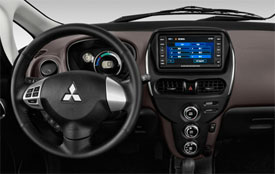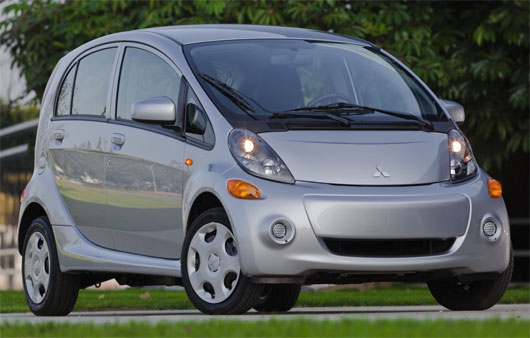2012 Mitsubishi I
Mitsubishi is no stranger to electric cars. They’ve been selling their tiny i-Miev EV in Japan and Europe since 2009. We even tried a pretty bare bones right hand drive model about a year ago. Well, now the US-spec Mitsubishi I model has arrived. It’s bigger, much better equipped, and is the least expensive highway-going EV you can buy. So, let’s see if the “i” has it all.
Well, one thing that the 2012 Mitsubishi i certainly has is a unique appearance. Sort of hard-boiled egg meets the Jetsons. Though the enlarger U.S.-spec i 5-door does have more presence. Whether you like it or loath it will pretty much depend on which side of the “Hey look at me and what I’m doing for the environment” fence you fall on.
The i’s 10 inches of added length, and 4 inches of increased width is accompanied by new front and rear bumpers re-designed to pass U.S. safety regs. With the huge windshield small vertical hood, and thin bubble headlights, the front end is indeed futuristic looking. Standard 15-inch wheels are pushed to the corners, with exaggerated fenders surrounding them. Our test car’s attention grabbing graphics aren’t included although some owners might want them! And the charging port is located on the right rear fender.
The i’s 16kWh lithium-ion battery pack is located low in the car’s chassis, helping keep the center of gravity near to the ground and interior room maximized. The rear mounted, rear-wheel drive 49kW electric motor is rated at 66-horsepower and 145 pound feet of torque. So, we weren’t expecting lightning fast acceleration and an uninstrumented 13.5 seconds to 60 miles per hour certainly isn’t.
In government testing the i achieved a real world driving range of 62 miles, which is less than the Nissan Leaf or Ford Focus Electric; our i indicated 73 miles when fully charged. A full charge takes 7 hours with 240 volts, up to 22 hours using 120, with a cost of about $3.
 Inside the new i’s wider cabin we quickly notice more space between the seats, with a re-designed console set between, and a normal looking shifter. The seats are cloth and a little utilitarian in feel, but comfortable enough to ride out the full EV range. Driver’s seat heat is standard. Gauges are EV-specific and include a power meter, as well as an info center with large distance to empty readout. Rear seats are hard, but with more length there’s plenty of room for 2, and seat backs fold 50/50, to expand the 13.2 cubic-feet of trunk space to a very useful 50.4.
Inside the new i’s wider cabin we quickly notice more space between the seats, with a re-designed console set between, and a normal looking shifter. The seats are cloth and a little utilitarian in feel, but comfortable enough to ride out the full EV range. Driver’s seat heat is standard. Gauges are EV-specific and include a power meter, as well as an info center with large distance to empty readout. Rear seats are hard, but with more length there’s plenty of room for 2, and seat backs fold 50/50, to expand the 13.2 cubic-feet of trunk space to a very useful 50.4.
A key fob remote allows you to monitor the state of the charge, and pre-heat or cool the cabin. Now, other EV’s offer similar features but require an app for a smart phone.
In typical EV fashion, driving the i takes a little getting used to, but we found the power adequate, and the ride smooth. Steering is very low effort, making low speed maneuvers a dream. The usual instant EV torque seems a little muted compared to other recent EV’s we’ve driven, but the i has no problems getting in to the flow of highway traffic. Top speed is 80.
 The additional size has gone a long way towards making the i feel more like a real car. It drives more substantial and less like an EV commuting device. Government Fuel Economy Miles Per Gallon Equivalency Ratings are 126–City, 99-Highway, and 112–Combined. That’s better than either the Leaf or Focus Electric. The i’s base price also bests them at $29,975. Government tax credits can reduce that by up to a third or better; our well equipped SE begins at $31,975.
The additional size has gone a long way towards making the i feel more like a real car. It drives more substantial and less like an EV commuting device. Government Fuel Economy Miles Per Gallon Equivalency Ratings are 126–City, 99-Highway, and 112–Combined. That’s better than either the Leaf or Focus Electric. The i’s base price also bests them at $29,975. Government tax credits can reduce that by up to a third or better; our well equipped SE begins at $31,975.
As more EVs emerge and competition grows, they will continue to gain efficiency with shorter charging times. And, like the 2012 Mitsubishi i, become cheaper to buy and attainable by more consumers. The i may not quite have it all, but it does have the lowest price and best MPGe rating of any 4 or 5 passenger pure electric going. And that’s certainly enough to make the i a serious EV player.
Specifications
- Engine: 49kW electric motor
- Horsepower: 66
- Torque: 145 lb-ft.
- 0-60 mph: 13.5 seconds
- EPA: 126 city/ 99 highway
2024 Polestar 2
More Range And More Power For The Polestar 2
Volvo is well on their way to making the transition to an all-electric brand, but their sister-brand Polestar is already there. Now, we’ve spent lots of time in their all-wheel drive, five-door Polestar 2, having tested it in 2021, and a year later when a two-wheel drive version arrived. But, EV updates are coming quickly. So, let us be your guide for all that’s new with the Polestar 2.
While we are driving more EVs than ever, we’ve also been spending a lot of time recently circling back to ones we’ve previously tested. As in this new era of electrified vehicles, significant updates are arriving quickly, with R&D investments increasing and retrofitting them easier than ever. This is often done through software updates that can even be accomplished over the air. For 2024, the Polestar 2 has indeed gotten some software updates, but some physical ones as well.
Clearly aimed directly at Tesla’s Model 3 when it arrived; the Polestar 2’s build quality was vastly better, but range definitely came up short. So, addressing that was priority No. 1; and for ’24 the Polestar can travel up to 20% farther than before while consuming 9% less energy, and when it comes time to charge it back up, it can do that 34% faster too.
Range in the Single Motor version increases from a max of 270 to 320 miles thanks to a larger 82-kWh battery pack, and that solitary motor now powers the rear wheels, not the front wheels. It’s also bigger, coming in at 220 kW compared to the previous 170 kW front-wheel drive version, going from 231 to 299 horsepower.
Dual Motors keep the same 78-kWh battery, but still sees a boost from 260 to 276 miles and takes advantage of the larger rear motor for a new combined 310-kW output with 421 horsepower. Our test car has the added Performance Pack, which uses an additional 35 kW to deliver 455 horsepower and 546 lb-ft of torque, though max range drops to just 247 miles.
The new battery in rear-drive 2s will also charge faster, now accepting up to 205 kW for an 80% charge in 20 minutes; max for dual-motors stays at 155 kW, which puts an 80% charge at 34 minutes. Using 32 kWh of electricity per 100 miles, the Dual Motor earns a good efficiency rating.
The [Polestar] 2 has always been one of the most enjoyable EVs to drive, even more so now with that additional power coming from the rear motor.
Unfortunately, extremely cold temperatures kept us from seeing that increased range, as we were only on pace for about 194 miles in our test.
The 2 has always been one of the most enjoyable EVs to drive, even more so now with that additional power coming from the rear motor. And especially when equipped with the Performance Pack as it not only includes more power, but adds 20-inch forged wheels, upgraded brakes, and adjustable Ohlins Dual Flow Valve performance dampers. It greatly improves handling prowess without affecting ride quality, and is easily worth the $5,500 charge if you at all enjoy driving.
Even on a 20-degree track day there was plenty of grip through our handling course. No understeer or oversteer, and lots of feedback through the wheel. There was a nice, strong launch off the line that properly planted us firmly in the seat, and rocketed us to 60 in 4.5 seconds. Power delivery stayed pretty intense up until about 80 mph when there was a definite tapering off. Still, it was a 13.4-second quarter-mile at 102 mph; smooth, quiet, and stable the whole way.
When this car debuted, its Google-based infotainment setup was a novelty, but since then, more and more manufacturers are just “Googling it” so it doesn’t seem out of place at all. The wireless phone charger is easy to access, and there’s a great Harmon/Kardon sound system and panoramic sunroof to enhance the in-cabin experience. Exteriors have also been enhanced with a smooth grille insert and new wheel choices.
Hatchback practicality means 14.3 cu-ft of easy to access cargo space with split-folding seatbacks for longer items and expanding the space to 38.7 cu-ft. Plus, there’s even a sizeable storage bin up front under the hood.
Single Motor Polestar 2 pricing now starts at $51,300, with Dual Motors starting at $56,700; topping out at $64,400.
For a car manufacturer that hasn’t even been around for a decade yet, Polestar has kept itself busy, totally transforming their latest model in just a few years, making the 2024 Polestar 2 even more appealing. They are certainly off to a good start, and with a host of Polestars just over the horizon, including some all-important utility vehicles, this star will be shining even brighter.
Specifications
As Tested
- Motor Setup: Dual Motor
- Horsepower: 455
- 0-60 mph: 4.5 seconds
- EPA Range: 247 miles
- Efficiency : 32 kWh / 100 miles
- Battery Size: 78-kWh
- Torque: 546 lb-ft
- 1/4 Mile: 13.4 seconds at 102 mph
- MW Test Loop: ~ 194 miles
- Peak Charging Rate: 155 kW











































